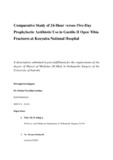| dc.contributor.author | Ondari, Joshua N | |
| dc.date.accessioned | 2015-09-24T08:12:47Z | |
| dc.date.available | 2015-09-24T08:12:47Z | |
| dc.date.issued | 2015 | |
| dc.identifier.uri | http://hdl.handle.net/11295/91424 | |
| dc.description.abstract | Background: Open fractures have been a challenge to clinicians for centuries and this scenario
persists in the 21st century. Management protocols have been devised over the years including
among others prophylactic antibiotic use (PAU). Optimum duration of antibiotic use has been
extensively researched but still remains unresolved although most studies have recommended 24
to 72 hours of prophylaxis. Furthermore, no protocol exists on PAU in our set up and most
clinicians prescribe for five days to several weeks. Therefore, there is need for further research in
the quest to improve the effectiveness of prophylactic antibiotic use and its adoption in developing
countries like Kenya.
Objective: To determine the difference in infection rate between 24 hours versus five days of
prophylactic antibiotic use for the management of Gustilo II open tibia fractures.
Design: Prospective randomized comparative interventional study.
Setting: Accident and Emergency department, orthopedic wards and orthopedic outpatient clinics
at KNH.
Patient and methods: The study involved patients aged 18 to 80 years admitted in the orthopedic
wards at KNH through A & E department with Gustilo II acute traumatic open tibia fractures and
subsequent follow up in the clinics. These were randomized into either the 24 hour or five day
group and antibiotics (Cefuroxime and Gentamycin) started at A &E department and continued
for 24hours or five days after surgical debridement. Patient demographics, wound characteristics
and fracture pattern were recorded after informed consent then antibiotics started. The wounds
were exposed and scored using ASEPSIS wound scoring system for any infection after 48 hours,
5 days and at 14 days.
Outcome measures: The main outcome measure was the presence of infection as determined at
day 2, 5 and 14 days. Antibiotics were restarted for those who developed infection as per the
diagnostic criteria.
Results: There was no significant difference in infection rates between 24-hour and 5-day
groups with infection rates of 23% (9/40) vs. 19% (7/37) respectively (p = 0.699). The infection
rate was significantly associated with time lapsed before administration of antibiotics (p =
0.004). Participants who received antibiotics less than 12 hours after admission were less likely
to develop infection than those who received antibiotics after 12 hours; 11% (5/45) vs 52%
(11/21) respectively. Infection rate was related to the time lapsed before debridement but the
association was not statistically significant (p = 0.08). Out of 13 patients who underwent
debridement within 12 hours, 2 (15%) developed infection as compared to 14 (29%) out of 48
patients who underwent debridement after 12 hours, (chi-sq, p = 0.72). Both groups had similar
culture growth rates with Staphylococcus aureus as the commonest isolate followed by
pseudomonas aeruginosa
Conclusion: In the use of prophylactic antibiotics for the management of Gustilo II traumatic open
tibia shaft fractures, there is no difference in terms of infection rate between 24 hours and five days
regimen. Time to debridement and fracture stabilization method does not seem to influence
infection rate but time to antibiotic administration correlates with infection rate. | en_US |
| dc.language.iso | en | en_US |
| dc.publisher | University of Nairobi | en_US |
| dc.title | Comparative study of 24-hour versus five-day prophylactic antibiotic use in gustilo ii open tibia fractures at Kenyatta National Hospital | en_US |
| dc.type | Thesis | en_US |
| dc.description.department | a
Department of Psychiatry, University of Nairobi, ; bDepartment of Mental Health, School of Medicine,
Moi University, Eldoret, Kenya | |
| dc.type.material | en_US | en_US |

